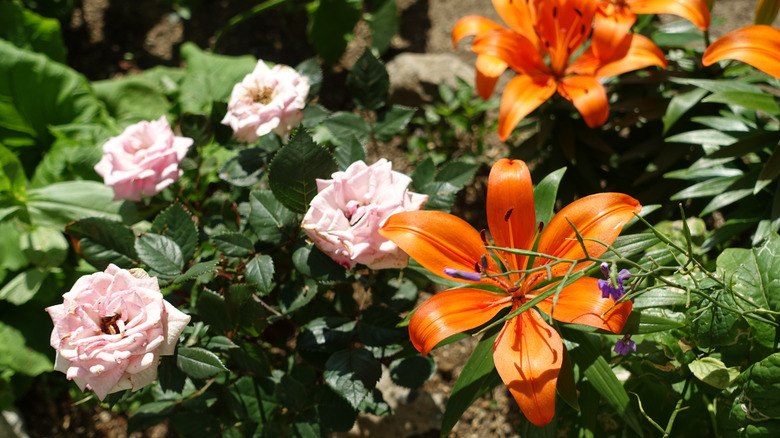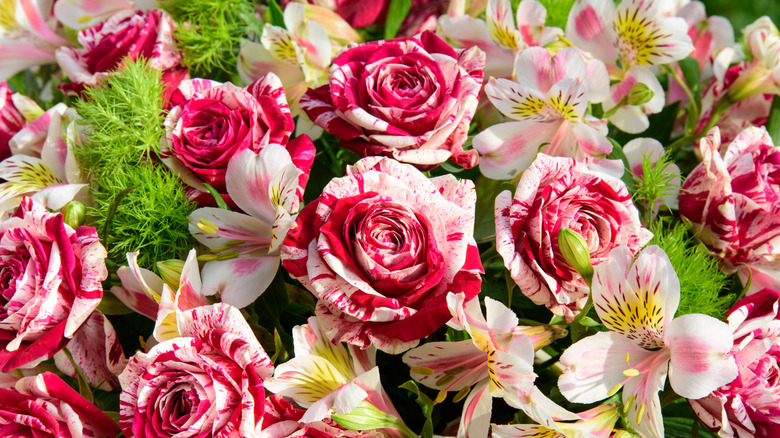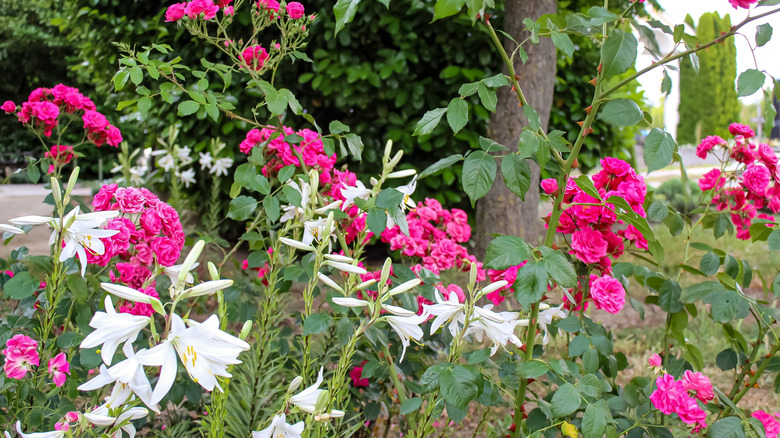The Benefit Of Growing Lilies And Roses Together In The Garden
Lilies and roses are two of the most beloved flowers in American gardens, and together, they make a classic and practical pairing for gardeners looking to blend beauty with balance. These two blooms are popular for their bold colors, pleasant fragrance, and ability to thrive in similar growing conditions. Roses, belonging to the genus Rosa, remain a top choice for many gardeners, while lilies, from the genus Lilium, are a close contender — especially in regions where upright, vibrant flowers can add height and contrast to garden beds.
Not only that, lilies and roses are also a classic pairing in bouquets, especially when timed to bloom together. Since different lily varieties bloom at different times, it's important to choose ones that flower around the same season as your roses. You can plant Asiatic lilies to get blooms just before spring and throughout the rose season, while planting Oriental and later-blooming lilies can help fill in the gaps further into the season. Hybrid tea roses that rebloom continuously, such as Rosa 'Double Delight' or 'Mister Lincoln,' grow well with sturdy Oriental lilies, like Lilium 'Stargazer' or 'Casa Blanca.' These combinations also offer a nice contrast in color, shape, and scent — giving you lovely garden views and fresh-cut bouquets straight from your backyard.
Companion planting perks and aesthetic appeal that lasts all seasons
As companions, lilies and roses offer more than just beauty. What makes this pair even more appealing is how well they complement each other, not just in looks but in care requirements, too. Both do best in full sun and well-draining soil with regular watering. Depending on the variety, roses generally grow well in USDA zones 5 to 9, while many lilies, including Lilium orientale, grow in zones 3 to 9.
Lilies are ideal companions for roses because of their vertical growth habit, which allows them to easily fit between rose bushes without taking up too much space. Moreover, lilies and roses create a beautiful contrast in the garden with their different shapes and colors. Roses tend to attract pollinators to your yard and garden as well, so your garden stays vibrant for a longer period. The taller lilies height also adds some visual interest behind the shorter rose bushes, making your garden look fuller and more layered.
Maintenance tips and things to watch out for
When growing lilies and roses together, make sure that they receive at least six hours of sunlight per day and consistent moisture. Both flowers prefer soil that is moist but well-draining and rich with organic matter. Mulching is also an important practice for these plants. Lilies benefit from a layer of organic mulch around their base, which helps conserve moisture and regulate soil temperature. Similarly, mulching helps your roses thrive as well, especially in the summer, by maintaining moisture, which improves their appearance.
While lilies and roses are a stunning combination in the garden, it's important to keep a few things in mind while choosing the best spot to plant lilies. Lilies, especially Easter lilies (Lilium longiflorum) and Asiatic lilies (Lilium asiaticum), can be toxic to cats if they nibble on them, so if your pets have free access to the garden, you should consider pet-safe alternatives. Lilium bulbs can also spread over time. While they aren't invasive, they do grow fairly quickly and may start to crowd your roses if they're not carefully spaced. Lastly, be sure to give them enough room when planting, spacing lily bulbs about 24 inches away from your rose bushes, and plan to divide the bulbs every few years. It's an easy way to make sure your garden stays full — but not overrun.


